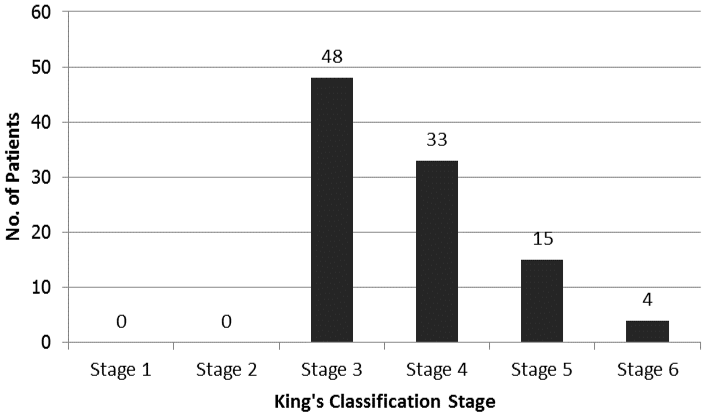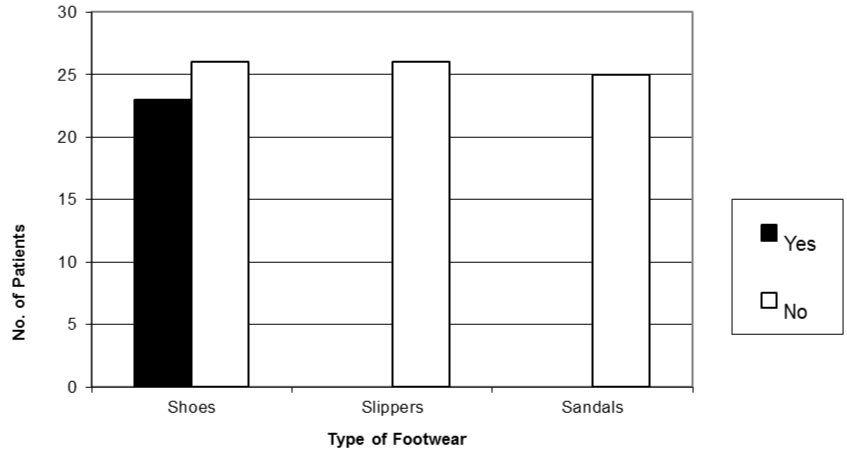Research Article
Volume 1 Issue 1 - 2016
Use of Protective Footwear for Patients with Diabetic Foot Problems
Department of Orthopaedic Surgery, National University Health System, Singapore
*Corresponding Author: Aziz Nather, University Orthopaedics, Hand & Reconstructive Microsurgery Cluster, National University Health System, Singapore.
Received: July 30, 2016; Published: August 05, 2016
Abstract
This is a study of protective footwear worn by 100 patients treated by the diabetic foot team in National University Hospital from January to June 2005. All patients had diabetic foot problems. 48% were King’s College Stage 3, 33% Stage 4, 15% Stage 5 and 4% Stage 6. All patients wore protective footwear outdoors but only 50% used covered shoes, the other half preferring to wear slippers or sandals. Of the footwear worn by the patients before they developed diabetic complications, rigid shank was absent in 21%, 42% lack fixation in the shoe, 50% had an enclosed heel while 77% could not accommodate a removable insole. This survey showed that more education is needed to guide diabetic patients to choose the appropriate footwear to be worn. Such footwear should have the desirable features of a rigid shank, good fixation in the shoe, presence of heel enclosure and potential to accommodate a removable insole. Patients should also be encouraged to wear socks when donning shoes.
Keywords: Footwear; Diabetics; Foot problems; Rigid shank; Fixation in shoe; Heel enclosure; Space for removable insole
Introduction
Diabetic foot ulcer is a frequent complication of diabetes. 15% of patients with diabetes will develop a foot ulcer at least once in their lifetime [1]. Foot ulceration is a high-risk factor for a below-knee amputation. 85% of amputations in diabetic patients are preceded by foot ulceration [2].
The key to the management of a diabetic foot ulcer lies in its prevention. All patients with diabetes should have annual foot screening to detect the foot at risk. In addition, at the time of foot screening, patient education should also be performed [3]. The latter must include not only the care of the foot and the use of protective footwear, but also the care of diabetes itself. This is because very often the patient with diabetes does not understand what diabetes is and how to take care of it.
It is important to encourage diabetic patients to wear protective footwear especially for outdoor walking. The use of footwear has been shown to reduce the risk of diabetic foot lesions by as much as 45% [4]. Protective footwear is important to prevent trauma to expose parts of the normal foot – toes, dorsum of foot, heel and to prevent ulcers from developing. Once a patient is diagnosed to have diabetes, the patients is advised to wear protective shoes to prevent the much dreaded complication of ulcer. The latter often leads to a below knee amputation. Such protective shoes are different from therapeutic shoes. The latter are custom made shoes used for treating patients who have developed diabetic foot complications i.e off-loading for neuropathic ulcer, post-operative shoes following ray amputation.
In the prescription of a protective shoe, the footwear should have the following desirable properties [5]
- Presence of a rigid shank to prevent friction in the skin.
- Presence of a good fixation to hold the foot securely.
- Presence of a heel enclosure to protect the exposed heel.
- Potential to accommodate a removable insole. This is important once therapy is required for i.e to apply custom made insole to be fitted into the protective shoe to provide off-loading.
- Socks should be worn to reduce friction in the skin.
This study aims to evaluate the use of footwear by patients with diabetic foot problems. It also evaluates the presence of the 5 desirable properties in the footwear selected.
Materials and Methods
The study population consisted of 100 patients with diabetic foot problems treated by the Multi-Disciplinary Team for Diabetic Foot Problems in National University Hospital from January to June 2005. The diabetic foot problems were classified according to the King’s College Foot Classification [6].
Patients were interviewed regarding the protective footwear they have been wearing before they have developed the diabetic foot complications using a detailed questionnaire. Parameters evaluated include type of footwear worn, the presence of rigid shank, type of fixation, presence of heel enclosure, ability to accommodate removable insole, as well as the use of socks.
Results
In the study population, there were 58 males and 42 females with a male to female ratio of 1.38:1. Their ages ranged from 22–90, the average being 58.5 (Figure 1). The majority (64%) were in the 5th and 6th decades of life. 51% of the patients were Chinese, 27% Malays, and 22% Indians.
With regards to King’s College Classification, 48 patients were Stage 3, 33 Stage 4, 15 Stage 5 and 4 Stage 6 Figure 2.
All patients wore footwear outdoors. Of these, 49% were shoes, 26% slippers and 25% sandals (Figure 3).
All A rigid shank was absent in 21% of the footwear worn outdoors. 8% was due to shoes and 13% due to sandals (Figure 4).
42% of patients used footwear that lacked any type of fixation – 19% in shoes and 23% in slippers. Laces were the most common fixation type (17%) but were found only in shoes (Figure 5).
Only half of the outdoor footwear investigated had heel enclosure – 48% were in shoes and 2 in sandals (Figure 6).
77% of footwear could not accommodate a removable insole. No slippers or sandals were able to accommodate a removable insole (Figure 7).
51% used socks – 40 in shoes, 3 in slippers and 8 in sandals (Figure 8).
Discussion
Study by Chandalia., et al. (2008) showed that only 0.6% walked barefoot outdoors [7]. Our findings were similar – all our patients wore protective footwear when walking outdoors. Protective footwear refers to footwear worn to protect the otherwise exposed normal feet to trauma and to prevent ulcer formation.
In the choice of footwear, rigid shank was present in 79% of the outdoor footwear used (Figure 4). Rigid shanks are useful as their presence in the shoe sole protects the foot against puncture injuries.
However, a large proportion of our patients (42%) used footwear that lacked any type of fixation (Figure 5). Good fixation is important because it prevents the foot from sliding within the shoe and rubbing excessively against the shoe interior. Using footwear without adequate fixation could lead to problems such as ulcers caused by friction of the shoe against the foot.
Also, 50% of the outdoor footwear worn has heel enclosure (Figure 6).
However, the majority of the outdoor footwear used (77%) could not accommodate a removable insole (Figure 7). For diabetic patients, it is important that the shoes selected must be able to accommodate a removable insole. Many of the patients require offloading using a removable well-cushioned, tailor-made insole.
With regards to wearing socks when donning footwear, we found that 18.4% of patients did not wear socks with their shoes (Figure 8). It is advisable for patients to wear socks with their shoes to absorb moisture and reduce friction between the foot and the inside of the shoe.
Conclusion
All our patients use footwear outdoors. With regards to type of footwear selected, a large proportion of the footwear do not have the features that are desirable for a diabetic patient: 21% did not have a rigid shank, 42% lacked any type of fixation and only half had heel enclosure. The majority (77%) could not accommodate a removable insole and only 51% used socks with their shoes.
Patient education is required to encourage more patients to use appropriate footwear. Education could emphasize the desirable features that should be present in the footwear selected.
Conflict of interest
The authors would like to declare that there is no conflict of interest.
The authors would like to declare that there is no conflict of interest.
References
- Reiber GE., et al. “Lower Extremity Foot Ulcerations and Amputations in Diabetes”. Diabetes in America 1995. 409. Print.
- Frykberg RG. “Epidemiology of the Diabetic Foot: Ulcerations and Amputations”. Contemporary Endocrinology: Clinical Management of Diabetic Neuropathy7(1998): 273.
- Nather A., et al. “Foot screening for diabetics”. ANNALS Academy of Medicine Singapore39.6 (2010): 472-475.
- Chantelau E., et al. “How effective is cushioned therapeutic footwear in protecting diabetic feet? A clinical study”. Diabetic Medicine 7.4 (1990): 355-359.
- Nather A., et al. “Diabetic Footwear: Current Status and Future Directions”. Diabetic Foot Problems (2008): 528.
- Edmonds ME., et al. “Footwear and foot care knowledge as risk factors for foot problems in Indian diabetics”. International Journal of Diabetes in Developing Countries28.4(2008): 109-113.
Citation:
Aziz Nather., et al. “Use of Protective Footwear for Patients with Diabetic Foot Problems”. Orthopaedic Surgery and Traumatology
1.1 (2016): 23-28.
Copyright: © 2016 Aziz Nather., et al. This is an open-access article distributed under the terms of the Creative Commons Attribution License, which permits unrestricted use, distribution, and reproduction in any medium, provided the original author and source are credited.











































 Scientia Ricerca is licensed and content of this site is available under a Creative Commons Attribution 4.0 International License.
Scientia Ricerca is licensed and content of this site is available under a Creative Commons Attribution 4.0 International License.